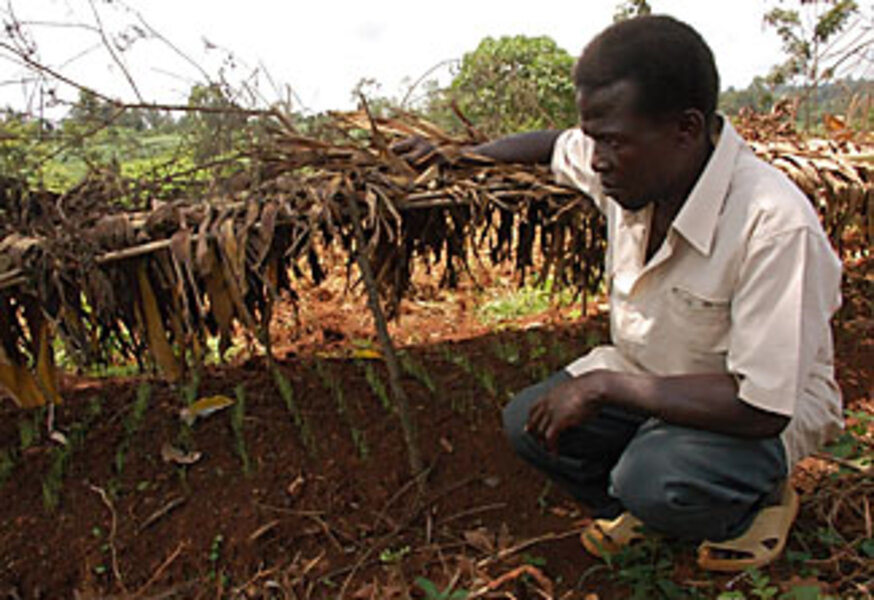How a Kenyan village tripled its corn harvest
| Sauri, Kenya
The dry months of April, May, and June were once equated with hunger for Agre Ranyondo and his neighbors in this community of 55,000 people.
Mr. Ranyondo, a farmer, waited for the rains to come before he could plant corn on his six-acre plot. Often the 10 bags of corn he harvested through two planting seasons weren't enough to feed his family of eight.
But the cycle of hunger was broken last year.
The change began in 2005, when Ranyondo met with agricultural extension workers dispatched by the Millennium Villages Project (MVP), an international organization conceived by economist Jeffrey Sachs of Columbia University's Earth Institute. He was given seeds better suited to the region, fertilizers, and was taught how to use them.
By 2007, Ranyondo had quintupled his annual output to 50 bags of corn, 20 of which he sold for cash and the other 30 he used to feed his family.
"We used to starve for these months, but now we are through starving," Ranyondo says. "The technical know-how in our farming is much improved."
Sauri is one of 80 Millennium Villages in 10 countries in Africa, where proven technologies, funded by donors, governments, and the community itself, are deployed to lift villagers in "hunger hot spots" out of poverty.
The project is not cheap. Each village operates on a budget of $110 per person per year over five years. The total cost: at least $1.5 million, a higher expenditure of aid than most development projects.
But increasingly these villages look to be oases of food security in Africa within the larger context of the global food crisis, which is hitting developing countries hard. Increasingly, the strategy for dealing with this crisis is to help small-scale farmers.
"No one is arguing anymore whether you can double production through input subsidies to small-holder farmers in most agricultural environments across Africa," says Glenn Denning, director of the Millennium Development Goals Center in Kenya. "We now have the evidence from the Millennium Villages that Africa holds tremendous potential to actually be the supply response to the global food crisis."
Since 2005, the prices of staples such corn, rice, and wheat have jumped 80 percent around the world. Yet, per capita food production has declined in Africa for the past 30 years and farm productivity is just one-quarter the global average, according to the Alliance for a Green Revolution in Africa. Here in Kenya, corn production dropped by 6.1 percent from 2006 to 2007, according to Kenya's 2008 Economic Survey. This year, experts predict a shortfall of 10 million bags – about a third of the country's consumption.
In Sauri, however, a cereal bank that offers its 3,800 members a place to sell and store surplus grain has a warehouse stacked high with bags of corn, emblematic of the region's high levels of production and opportunity for profit from current high prices for farmers like Ranyondo. "As the whole of Kenya is pressing towards hunger, this place is different," says Willis Ombai, a program coordinator with the Sauri MVP.
The Millennium Villages are still small examples and face significant challenges in scaling up to district or provincial levels. But throughout the network of 11 villages that make up the Sauri community, corn production has on average more than tripled. The core of the strategy is a short-term provision of improved seeds suited to the local environment and fertilizers like Di-Ammonium Phosphate (DAP) and urea accompanied by advice on how to use them.
After two years, the subsidy ends. Farmers can get a loan from the cereal bank if they do not have the cash to buy the fertilizer and better seeds. In Ranyondo's case, he made enough profit on the sale of his corn to pay for seeds and other inputs.
But many obstacles remain in applying the model on a larger scale. The Sauri project, for example, has not yet found enough support in Kenya to scale up to the district level. Meanwhile, the price of petrochemical fertilizers, closely tied to the price of oil, is expected to climb by 70 percent.
Sam Rich, a consultant who criticized the Sauri project in the Wilson Quarterly magazine last year, noted that farmers in Kenya don't buy fertilizer because it costs three times as much as it does in Europe. They could boost productivity by simply easing taxes and import duties on fertilizer, he added.
But the food crisis has put a fresh spotlight on the MVP strategy, and proponents point to Malawi as an example of it working on a larger scale. Malawi has doubled its annual corn production since 2004, allowing for self-sufficiency and some surplus for sale to other nations.
A number of other African countries are now waiting for the funding to implement a similar national program, including Tanzania and Rwanda.
"We need to move very quickly and get a financing mechanism so that these countries can access funds to pay for seeds and fertilizers and train extension workers," says Denning.





